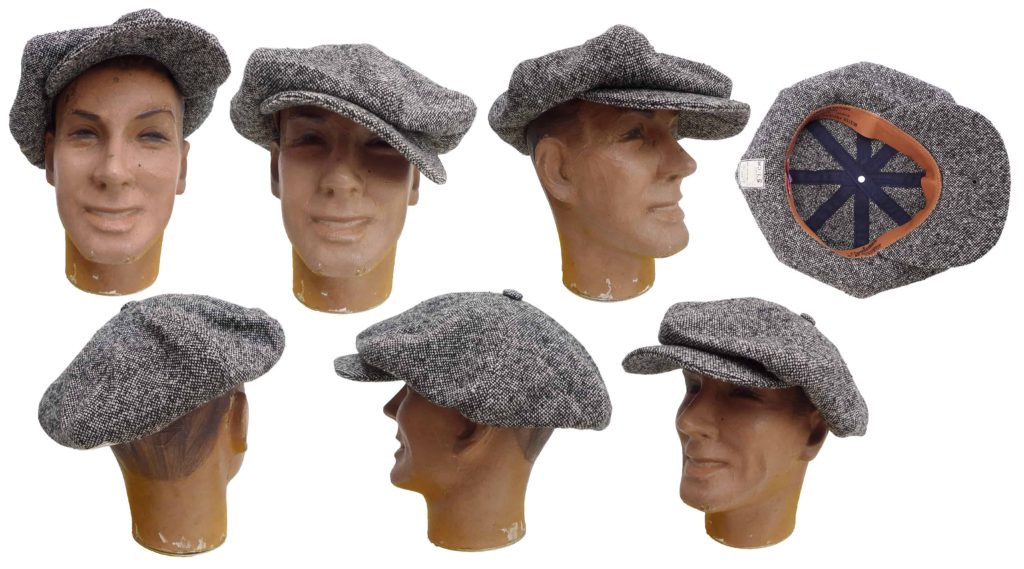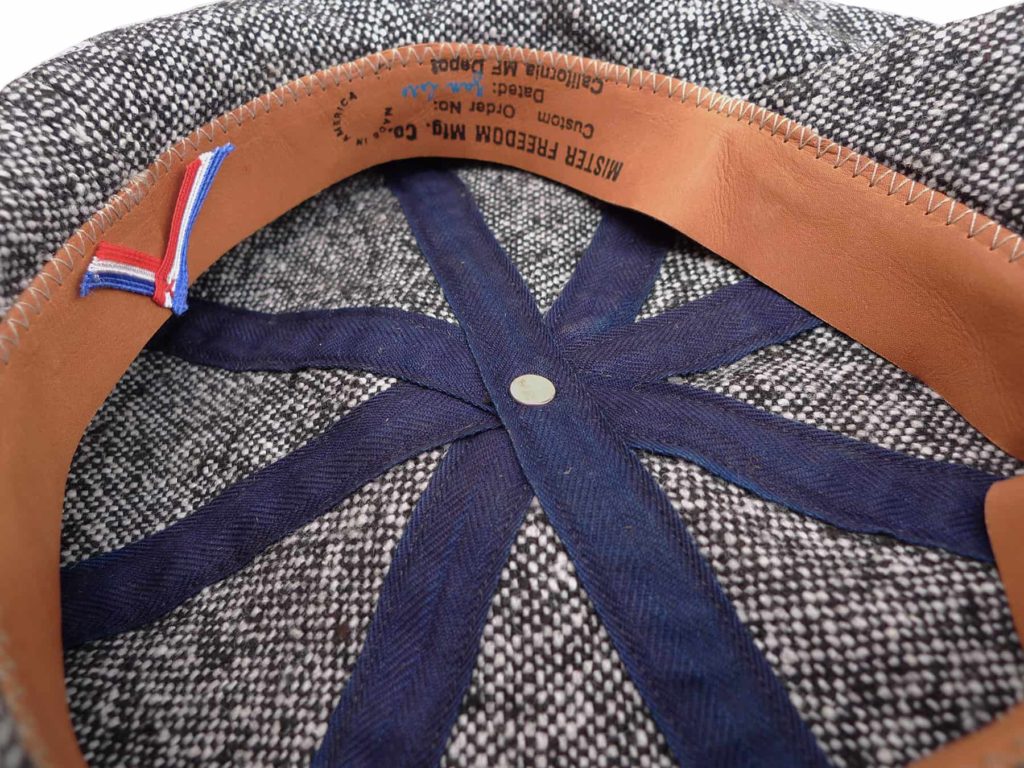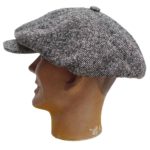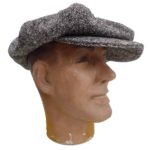


Mister Freedom® SCUTTLER CAP, NOS Wool Tweed edition.
Made in USA.
(This is a March 2020 updated version of this June 2018 post.)
If you are in a Peaky Blinders or Jack Sparrow kinda mood, here is the latest addition to the original MF® “Scuttler Cap” pattern. Initially introduced in 2013, this hat is our interpretation of the popular vintage newsboy eight-panel cover.
While Paris of the Belle Époque had its ‘Apaches’, Manchester enjoyed the ‘Scuttlers’, all victims, misfits and drop-outs left by the wayside of the Second Industrial Revolution…
In “Teenage, Creation of Youth 1875-1945”, British writer Jon Savage describes their attire this way, quoting a period account from the head missionary of a Manchester orphanage in 1890:
“…the “professional scuttler” wore “a puncher’s cap”, “narrow-go-wides” trousers, narrow-toed brass-tipped clogs, and heavy customized belts with designs, picked out in metal pins, that included serpents, stars, and pierced hearts. The “boy expert” Charles Russell observed that the Mancunian variant wore “a loose white scarf”, with hair “well plastered down upon his forehead”, “a peaked cap rather over one eye”, and trousers “cut – like a sailor’s – with ‘bell bottoms’”
The fabrics of our “Scuttler Caps” have been NOS (New Old Stock) textiles, 1940’s to 1970’s. This latest one is a wool tweed with a very textured grain and a definite vintage demeanor.
Please note that the sizing paper label stitched to the back of the cap, a reference to vintage packaging, is easily removable and not part of permanent branding.
The MF® Scuttler Cap is designed and made in California by Mister Freedom®.
SPECS:
* An original MF® pattern inspired by vintage 1930’s newsboy eight-panel caps.
* Genuine kangaroo leather sweatband (stretch-proof and rot-proof).
* NOS cotton biased tape seam piecing.
* Made in USA.
SIZING:
To avoid confusion, we recommend wearing the Scuttler Cap as-is, without rinsing it.
We measure the sweatband in centimeters. If unsure, measure your head with a metric cloth tape measure to determine your hat size. Kangaroo leather will not stretch or shrink but the hat crown might loosen slightly with normal wear.
CARE:
Professional cleaning only. Do not machine-wash.
Available raw/unwashed.
Limited sizes available per fabric option. See updated inventory here.
57cm (~ US 7 1/8)
58cm (~ US 7 1/4)
59cm (~ US 7 3/8)
60cm (~ US 7 1/2)
61cm (~ US 7 5/8)
62cm (~ US 7 3/4)
Available from www.misterfreedom.com and our Los Angeles brick & mortar store.
Email [email protected] or call 323-653-2014 with any questions unanswered above.
Thank you for your support.
Christophe Loiron
Mister Freedom®
©2020














Mister Freedom® “DUDE RANCHER” western snap shirt, vat-dyed selvedge chambray & shadow-plaid printed poplin.
SS2020 mfsc “DUDE RANCH” collection & Surplus catalog.
Made in Japan.
The Mister Freedom® APPALOOSA introduced during Fall 2013 and released in a variety of denim-related fabrics was our first traditional “western snap” shirt. The “DUDE RANCHER” is our second spin on the style. This all-original pattern was inspired by a selection of vintage “cowboy” shirts, and initially issued in high-count cotton poplin during Spring 2019, available in solid black and white, with a limited edition “rodeo” batch custom chainstitch-embroidered.
The DUDE RANCHER features the expected western-style front and back curved yokes, but we opted for arcuate panels subtle-enough to keep the shirt not too “costumey”. The playful “M” branding on the chest pockets is disguised as decorative stitching. The tricked-out forearm pattern and intricate one-piece elbow/cuff reinforcement diamond-shaped placket is quite a garment construction tour de force, for anyone who knows his/her way around a sewing machine.
Our DUDE RANCHER features painted metal snaps, reminiscent of 50’s Ranchcraft or Blue Bell shirts, previously featured on the MF® Sportsman printed flannel Camp Shirts. If pearl snap buttons are more-commonly associated with traditional western shirts, these metal snaps are a bit more subdued and utilitarian.
For this SS2020 release, we decided to go “Hee Haw meets Oklahoma!”, with a vibrant orange/green/yellow printed plaid poplin option. This period-looking check pattern was lifted verbatim from a vintage 1920s-30s garment from the MF® archives, also printed on high-count poplin. The “shadowed” plaid pattern has a definitive Art Deco vibe, reminiscent of bygone airbrush shading techniques. See the works of Dorothy and Otis Shepard, the power-couple geniuses behind Wringley’s chewing gum wrapper and countless of other 1930s billboards, paper ads and packaging.
This flashy number in Technicolor® is in sharp contrast with the vat-dyed selvedge chambray fabric option, kinda taking after Junior Bonner rather than 1950s Grand Ole Opry. If “traditional” chambray cloth is a plain weave of a colored warp (indigo for a blue chambray) and white weft, our vat-dyed chambray features light indigo-dyed yarn in both warp and weft, giving the fabric the appearance of a solid colored textile. Closer inspection will reveal the much more interesting and attractive grainy texture of classic chambrays. This characteristic definitely sets vat-dyed fabrics apart from regular piece-dyed fabrics (dyed after milling) and their ‘flat’, solid uniform color.
Vat-dyed chambrays were a popular novelty in 1940s-50s workwear, with fabric producers like PEPPERELL (Boston, Massachusetts) boasting of their colorfast, sunfast or “Will Not Fade” qualities.
Our choice of contrast stitching for the chambray model is a nod to the classic 1970s light-weight Levi’s chambrays familiar to vintage clothing aficionados. My Dad was a big fan, as I remember that vivid orange tab on the chest pocket, magically enhancing the faded blue fabric.
We combined orange and yellow thread for the caballo chainstitch, a subtle dual color contrast touch. The DUDE RANCHER features high-count stitching, contributing to the shirt’s vintage look, without having to resort to unnecessary processing, chemical washes or sandblasting. In these days of fast fashion, very few factories are still willing or qualified to operate the machines that allow such high-count stitching and narrow seams, so we are grateful for our friends at Toyo Enterprises for keeping this quality production level available. Such attention to details also delays production drastically, as each shirt takes about 3 times longer to complete. It goes without saying that this comes at a price, which the reader is very well aware of!
The DUDE RANCHER western snap shirt is designed in California by Mister Freedom® and manufactured in Japan by Sugar Cane Co.
FABRIC:
Two options:
a) Printed “shadow” plaid, high-count 100% cotton poplin, partial bleed-though, made in Japan.
b) Vat-dyed chambray, 100% cotton, light indigo blue solid color, solid white selvedge ID, milled in Japan.
SPECS:
* An original mfsc pattern, inspired by traditional western-style shirts.
* Traditional western-wear arcuate front and back yokes.
* Attractive pointy pocket flaps, complementing the yoke pattern.
* 1950’s-style painted metal snaps (the paint will chip with age.)
* Tonal stitching for plaid model, dual contrast orange/yellow stitching for chambray version.
* Original curvy “M” decorative stitching on pockets.
* Fancy diamond-shaped cuff/elbow reinforcement patch.
* Vintage style side gussets.
* Rounded shirt tails.
* 100% cotton hi-count stitching.
* Original MF® mfsc “Surplus” woven label.
* Made in Japan.
SIZING/WASHING:
Both versions of the DUDE RANCHER come RAW/unwashed. This shirt is cut so that the measurements match the labeling after an initial cold soak/line dry.
We recommend this usual protocol before wearing:
- Cold soak for about 30-40mn, with occasional hand agitation.
- Spin dry and line dry.
- Hang until fully dry.
I opted for a MEDIUM in both fabric options (my usual size in mfsc shirting), for a trim, traditional western “cowboy” shirt fit.
Please refer to sizing chart for approximate raw/soaked measurements. Soaked = 30mn cold soak, spin dry and line dry.
CHART
CARE:
Machine wash on DELICATE, cold water, mild eco-friendly detergent. Hang dry.
Wash with similar-colored garments.
Do not use the washer’s heavy-duty cycle. Heat dryer is also not recommended and could damage the garment.
Available RAW (un-rinsed)
Sizes
X-Small
Small
Medium
Large
X-Large
XX-Large
Available from www.misterfreedom.com, our Los Angeles brick & mortar store, and fine retailers around the World.
Email [email protected] or call 323-653-2014 with any questions unanswered above.
Thank you for your support.
Christophe Loiron
Mister Freedom®
©2020
 










Mister Freedom® mfsc RANCH KERCHIEF, selvedge cotton.
SS2020 mfsc “DUDE RANCH” collection, made in Japan.
We dug-out some vintage Old West-related silk scarves from the Mister Freedom® archives for inspiration, and put together this original “RANCH KERCHIEF”, in full 1950s-60s “dude ranch” tenderfoot fashion. Like the singing cowboy Rex Allen once confessed sometime around 1958, in regards to his TV fancy wardrobe: “I recon I wear seersucker suits. Sears made ‘em and a sucker bought ‘em.” Cowboy wisdom.
Cinema and music have reinvented the American West since the 1930s (or earlier), often depicting an “on the range” reality that might not have been everyone’s experience of it.
To keep things light, our bandana sticks to that romanticized version of cowpoke life, a bit more “Oklahoma!” than “Dead Wood”. Its novelty artwork does not incorporate any “cool” Native American symbols or references, a minefield these days. Save for the obscur “MF” and “SC” branding iron repeats, there is no maker mention either, but that’s just because we were so busy picking colors that we actually forgot to include our brand name!
The print is made on an all cotton plain weave selvedge fabric base, using water-based ink. A bleed-thru effect guarantees that both sides display the graphic with equal sharpness and vibrance.
Like most traditional 1950s-1960s fashion or promotional bandanas, our RANCH KERCHIEF features three sides machine-hemmed and one side using the fabric selvedge, an old sign of fabric yield maximizing. Modern mass-produced generic bandanas tend to be hemmed on all four sides (fabrics milled on wide looms with frayed edges), sometimes unattractively serged (overlocked), and, ultimate deal-breaker, cut from polycotton for some. Besides the few attractive vintage replicas/interpretations available today from discerning labels, selvedge bandanas are not the norm.
We opted for a classic average square size of 23 x 23 inches, so that our RANCH KERCHIEF can be used as neckwear, do-rag, dust mask, hankie, wall display, sling, pocket square, napkin, field tourniquet, pet scarf, furoshiki etc…
This SS2020 release comes in four colorways we are calling red, navy, gold and green to simplify.
We devised the original kraft paper packaging as to not include a PVC plastic window, playing around with the concept of a vintage souvenir brought home from a guest ranch vacation.
The mfsc RANCH KERCHIEF is designed in California by Mister Freedom® and manufactured in Japan by SugarCane Co.
SPECS:
FABRIC:
Fine 100% cotton, traditional selvedge “bandana” lightweight fabric, milled and printed in Japan.
Four classic colorways: red, navy, gold or green.
DETAILS:
* Vintage-inspired 1950s-60s dude ranch cowboy/western artwork.
* Fabric selvedge featured on one side, with other three edges finished with narrow hem.
* Water-based ink for soft-hand print.
* Approximate size 23 x 23 inches ( about 58 x 58 cm.)
* Packaged in an original vintage-like kraft paper envelope, a fun present for your significant cowboy, cowgirl, cowperson, or pet.
* Made in Japan.
CARE:
These bandanas come raw/unwashed. We recommend a full wash before using, to remove the starched finish and soften-up the fabric.
The RANCH KERCHIEF is low maintenance and should be laundered when needed.
Machine wash on normal cycle, cold or warm water, minimal eco-friendly detergent. Line dry of tumble dry.
Available Raw/Unwashed.
One size, four color options.
Available from www.misterfreedom.com, our Los Angeles red brick HQ, and fine retailers around the World.
Email [email protected] or call 323-653-2014 with any questions unanswered above.
Thank you for your support,
Christophe Loiron
Mister Freedom®
©2020


LONGSHOREMAN Shirt, model A: 7.7 Oz. indigo linen-cotton HBT.







LONGSHOREMAN Shirt, model B: 10 Oz. “Snow” denim.








Mister Freedom® LONGSHOREMAN Shirt, indigo linen-cotton HBT & 10 Oz. “Snow” denim edition.
mfsc SS2020 “WATERFRONT SURPLUS”, SURPLUS catalog.
Made in Japan.
We took a stroll down memory lane and rigged-up a small capsule collection for Spring 2020, with references harking back to our earliest Mister Freedom® x Sugar Cane Co fictional scenario, the 2006 “MFSC Naval Clothing Tailor”. This concise “Waterfront Surplus” nautical grouping is inspired by 1930’s US Navy and French Marine Nationale utility uniforms, local-made and custom-tailored dungarees, with the usual liberties we like to take with History. This straight-forward and classic set is made of the DOCKYARD Jacket, LONGSHOREMAN Shirt, and SWABBIES Dungarees.
Following the recent release of the DOCKYARD Jacket in indigo linen-cotton HBT and “snow” denim, here is Volume Two, the LONGSHOREMAN Shirt, available in the same two fabric options.
The overall design of this pull-over “jumper” shirt is lifted from a rare 1940s vintage naval denim work shirt produced by the “Gus Kroesen Uniform” label. Established in 1907, and with branches in Seattle, San Francisco and Honolulu, the Gus Kroesen stores have supplied generations of men of the sea with outstanding custom uniforms.
According to a 1924 article of the San Pedro News Pilot, “Gus Kroesen, naval and civilian tailor and haberdasher, with a very attractive and well-stocked store at 335 Front street, San Pedro, served for fourteen years as a ship’s tailor in the U.S. Navy.” (quote credit California Digital Newspaper Collection, Center for Bibliographic Studies and Research, University of California, Riverside.)
Today, surviving vintage specimen of Gus Kroesen naval dungarees are quite rare and sought-after by collectors.

The Mister Freedom® LONGSHOREMAN Shirt features most of the design specifics of the vintage original, the jumper style pattern (aka pop-over), half zipper front closure placket, and three utilitarian patch pockets.
One of the striking details of the Gus Kroesen shirt was the unusual use of the fabric grain in construction. Classic shirt bodies tend to be cut using straight grain (displaying the warp threads vertically), but our vintage jumper featured vertical cross grain. I have seen a few of these private-purchase naval dungaree jumpers from various makers, and this is typical of that style. The purpose was to maximize yield and minimize fabric waste, using the selvedge in the bottom hem, cuff hems, and pocket fold. As a side effect, the combination of grain directions will result in interesting seam puckering, peculiar garment drape, and potential attractive “striped” patina over time.
If our indigo HBT fabric is non-selvedge, both LONGSHOREMAN options are cut using the same grain cutting method, promising some interesting fading evolution in both fabrics.
To add a little twist à la MF®, we decided to add a classic period detail in the form of a narrow chin strap, and a practical concealed chest pocket.
The LONGSHOREMAN Shirt is designed in California by Mister Freedom® and manufactured in Japan in collaboration with Sugar Cane Co.
SPECS:
FABRIC:
Model A: 7.7 Oz. dark indigo-dyed Herringbone Twill (HBT) fabric, blend of 60% linen and 40% cotton. Milled in Japan.
Model B: 10 Oz. dark indigo blue 2×1 denim, “snowy” neppy texture, white with yellow line selvedge ID. Milled in Japan.
DETAILS:
* Inspired by 1930s-40s custom-made private purchase naval dungarees and shipyard crews work clothing.
* Pull-over style “jumper” pattern.
* Half zipper closure placket, 30s/40s-style bell-shaped pull “silver” Talon zipper, 100% cotton tape. (use caution when fastening, as these vintage-style zippers are more delicate than modern versions with polyester tape. Lubricate the metal teeth with natural beeswax occasionally.)
* Fabric cut using vertical cross grain for body and sleeves, displaying the warp horizontally.
* Selvedge displayed in bottom hem, cuff hems, and pocket fold (denim version only.)
* Three front utilitarian patch pockets.
* Concealed chest pocket, stripe ticking fabric.
* Clean chainstitch construction, no open seams.
* Mister Freedom® mfsc woven rayon “SURPLUS” label.
* Made in Japan.
SIZING/FIT:
The following applies to both fabric options. The MF® LONGSHOREMAN Shirt comes raw/unwashed and is cut so that the measurements match the labeling after an initial cold soak/line dry.
We recommend this usual protocol before wearing:
- Cold soak for about 30-40mn, with occasional hand agitation.
- Spin dry and line dry.
- Hang until fully dry.
Due to the 100% cotton stitching and specific grain cutting method, attractive puckering will show at the seams after the soak, giving the garment more of a vintage feel. The denim version will be stiffer after the initial soak due to the re-activated starch, but the stiffness is temporary and will subside rapidly with wear.
I opted for a comfortable 38 (MEDIUM) in both fabric options, both with a similar fit but different drape. The silhouette is quite slim yet comfortable enough not to make pulling the shirt on/off an excruciating task. According to body types, the cut will accommodate layering with a skivvy or classic Nixon chambray.
We recommend going with your usual mfsc shirt size.
Please refer to sizing chart for approximate raw/soaked measurements.
Soaked = 30-40mn cold soak, spin dry and line dry (ie. minimal shrinkage).
CHART
Available RAW/unwashed.
CARE:
Launder when needed. For both options, we recommend turning the LONGSHOREMAN Shirt inside out, fully zipped-up, to avoid marbling of the fabric.
Machine wash on gentle cycle, cold water, minimum eco-friendly mild detergent and line dry.
Patina will develop according to activities and frequency of wear.
Available Raw/unwashed ONLY.
Sizes
34 X-small (indigo HBT only)
36 Small
38 Medium
40 Large
42 X-Large
44 XX-Large
Available from www.misterfreedom.com, our Los Angeles red brick HQ, and fine retailers around the World.
Email [email protected] or call 323-653-2014 with any questions unanswered above.
Thank you for your support,
Christophe Loiron
Mister Freedom®
©2020

DOCKYARD Jacket, model A: 7.7 Oz. indigo linen-cotton HBT.







DOCKYARD Jacket, model B: 10 Oz. “Snow” denim.







Mister Freedom® DOCKYARD Jacket, indigo linen-cotton HBT & 10 Oz. “Snow” denim edition.
mfsc SS2020 “WATERFRONT SURPLUS”, SURPLUS catalog.
Made in Japan.
We took a stroll down memory lane and rigged-up a small capsule collection for Spring 2020, with references harking back to our earliest Mister Freedom® x Sugar Cane Co fictional scenario, the 2006 “MFSC Naval Clothing Tailor”. This concise “Waterfront Surplus” nautical grouping is inspired by 1930’s US Navy and French Marine Nationale utility uniforms, local-made and custom-tailored dungarees, with the usual liberties we like to take with History. This straight-forward and classic set is made of the DOCKYARD Jacket, LONGSHOREMAN Shirt, and SWABBIES Dungarees.
First to hit port is the DOCKYARD Jacket.
What could look like yet-another spin on a 1940’s regulation USN denim shawl collar seaman jacket, a profusely-replicated pattern in Heritage Fashion, is actually inspired by a rare French 1930s “Chantier naval” (shipyard) jacket. Our good friend and vintage collector/hunter Jérome Le Zouave, aka le “J”, gets all the credit for unearthing a batch of these gems last year, in a wild goose chase only he knows the secret of. One of these babies made its way to Sunny California and is now part of MF® archives.
As an unusual piece of militaria, the model’s history is not 100% clear to me, but these jackets were apparently a 1930s civilian contract to outfit French Navy shipyard workers. A well-worn lot of survivors ended-up as Government surplus in a French warehouse, and several specimen resurfaced last year. Jérome mentioned he could tell me more… but he’d have to kill me right after.
If the vintage model was stunning, the fit was as expected quite awful, so the pattern underwent a full rebuild. Our version is not a verbatim replica, but does keep the original’s main features and overall nautical vibe, with its shawl collar, two hip patch pockets, and specific cuffs. We spiced things up a bit by adding a removable chinstrap to the collar, and two inside chest pockets. We kept the rear panel two inconspicuous cinching darts, initially intended to be unsewn by the wearer for extra width if needed, in a typical display of utilitarian clothing design where function, practicality, and longevity prevail. It could be pointed-out that this is why the H&M label is hardly notorious its workwear.
We are releasing our DOCKYARD Jacket in two distinct fabrics, both a departure from the original garment, as that would have been too easy. The first option is a dark indigo-dyed HBT fabric, a fancy blend of 60% linen and 40% cotton. The second, a dark and handsome 2×1 selvedge denim with a “snowy” neppy texture, an old mfsc favorite previously featured on our 2015 Tonkinoise. One of the photo above features a worn Tonkinoise rubbing elbows with a raw DOCKYARD, and showing some denim evolution. With proper wear and care, one can anticipate an attractive indigo patina with both versions.
For the front closure of the indigo HBT model, we opted for genuine bone buttons, all with subtle color and surface variations. The denim version features black painted 1940s-style donut wreath buttons. The denim fabric selvedge is displayed on the button placket facing and cuff facing.
Stay tuned for the soon-to-be-released remaining pieces of the “Waterfront Surplus” set!
The DOCKYARD Jacket is designed in California by Mister Freedom® and manufactured in Japan in collaboration with Sugar Cane Co.
SPECS:
FABRIC:
Model A: 7.7 Oz. dark indigo-dyed Herringbone Twill (HBT) fabric, blend of 60% linen and 40% cotton. Milled in Japan.
Model B: 10 Oz. dark indigo blue 2×1 denim, “snowy” neppy texture, white with yellow line selvedge ID. Milled in Japan.
DETAILS:
* An original mfsc pattern inspired by a rare 1930s French Navy/civilian shipyard utility jacket.
* Shawl collar with removable chinstrap.
* Two hip patch pockets.
* Genuine bone buttons (HBT model), or black donut wreath buttons (denim model)
* Selvedge button placket facing and cuff facing (denim model only)
* Adjustable cuffs.
* Two concealed chest pockets, stripe ticking fabric.
* Back panel cinching darts.
* Chainstitch construction, no open seams.
* Mister Freedom® mfsc woven rayon “SURPLUS” label.
* Made in Japan.
SIZING/FIT:
The following applies to both fabric options. The MF® DOCKYARD Jacket comes raw/unwashed and is cut so that the measurements match the labeling after an initial cold soak/line dry.
We recommend this usual protocol before wearing:
- Cold soak for about 30-40mn, with occasional hand agitation.
- Spin dry and line dry.
- Hang until fully dry.
Due to the 100% cotton stitching, some attractive puckering will show at the seams after the soak, giving the jacket more of a vintage feel. The denim version will be stiffer after the initial soak due to the re-activated starch but the stiffness is temporary and will subside rapidly with wear.
I opted for a comfortable 38 (MEDIUM) in both fabric options, both with a similar fit but different drape.
Please refer to sizing chart for approximate raw/soaked measurements.
Soaked = 30-40mn cold soak, spin dry and line dry (ie. minimal shrinkage).
CHART
Available RAW/unwashed.
CARE:
Launder when needed. For both options, we recommend turning the DOCKYARD Jacket inside out to avoid marbling of the fabric.
Machine wash on gentle cycle, cold water, minimum eco-friendly mild detergent and line dry.
Patina will develop according to activities and frequency of wear.
Available Raw/unwashed ONLY.
Sizes
34 X-small (indigo HBT only)
36 Small
38 Medium
40 Large
42 X-Large
44 XX-Large
Available from www.misterfreedom.com, our Los Angeles red brick HQ, and fine retailers around the World.
Email [email protected] or call 323-653-2014 with any questions unanswered above.
Thank you for your support,
Christophe Loiron
Mister Freedom®
©2020
|



































































































